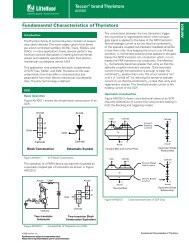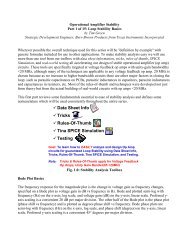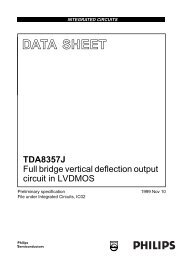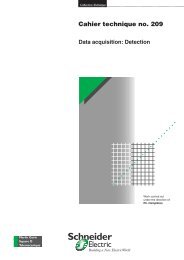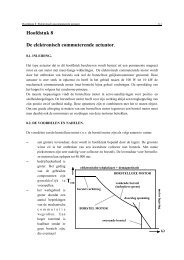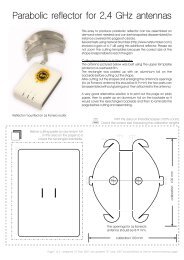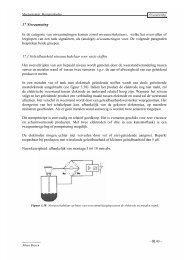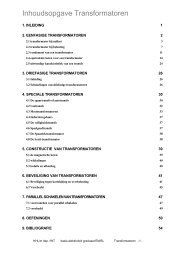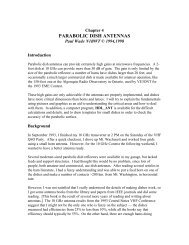Create successful ePaper yourself
Turn your PDF publications into a flip-book with our unique Google optimized e-Paper software.
Introduction<br />
The CA3094 unique monolithic programmable power<br />
switch/amplifier IC consists of a high-gain preamplifier driving<br />
a power-output amplifier stage. It can deliver average power of<br />
3 watts of peak power of 10W to an external load, and can be<br />
operated from either a single or dual power supply. This Note<br />
briefly describes the characteristics of the CA3094, and<br />
illustrates its use in the following circuit applications:<br />
• Class A Instrumentations and <strong>Power</strong> <strong>Amplifier</strong>s<br />
• Class A Driver-<strong>Amplifier</strong> for Complementary <strong>Power</strong><br />
Transistors<br />
• Wide Frequency Range <strong>Power</strong> Multivibrators<br />
• Current- or Voltage Controlled Oscillators<br />
• Comparators (Threshold Detectors)<br />
• Voltage Regulators<br />
• Analog Timers (Long Time Delays)<br />
• Alarm Systems<br />
• Motor-Speed Controllers<br />
• Thyristor Firing Circuits<br />
• Battery Charger Regulator Circuit<br />
• Ground Fault Interrupter Circuits<br />
DIFF.<br />
VOLTAGE<br />
INPUT<br />
2<br />
DIFF.<br />
VOLTAGE<br />
INPUT<br />
AMPLIFIER<br />
BIAS INPUT<br />
I ABC<br />
Q4<br />
3<br />
Q1<br />
D2<br />
Q2<br />
Q5<br />
4-165<br />
D3<br />
5 Q3<br />
D1<br />
Some Applications of a Programmable<br />
<strong>Power</strong> <strong>Switch</strong>/<strong>Amplifier</strong><br />
Application Note April 1994<br />
AN6048.1<br />
Authors: L.R. Campbell and H.A. Wittlinger<br />
EXTERNAL FREQUENCY<br />
COMPENSATION OR INHIBIT INPUT<br />
Q7<br />
Q6<br />
D4<br />
Q11<br />
Q9<br />
D5<br />
Q8<br />
Q10<br />
1<br />
R1 47kΩ<br />
D6<br />
4<br />
Circuit Description<br />
FIGURE 1. CA3094 CIRCUIT SCHEMATIC DIAGRAM<br />
7<br />
V-<br />
Q12<br />
The CA3094 series of devices offers a unique combination<br />
of circuit flexibility and power-handling capability. Although<br />
these monolithic ICs dissipate only a few microwatts when<br />
quiescent, they have a high current-output capability (100mA<br />
average, 300mA peak) in the active state, and the premiumgrade<br />
devices can operate at supply voltages up to 44V.<br />
Figure 1 shows a schematic diagram of the CA3094. The<br />
portion of the circuit preceding transistors Q12 and Q13 is<br />
the preamplifier section and is generically similar to that of<br />
the CA3080 Operational Transconductance <strong>Amplifier</strong> (OTA)<br />
[1, 2]. The CA3094 circuits can be gain-programmed by<br />
either digital and/or analog signals applied to a separate<br />
<strong>Amplifier</strong>-Bias-Current (I ABC ) terminal (No. 5 in Figure 1) to<br />
control circuit sensitivity. Response of the amplifier is<br />
essentially liner as a function of the current at terminal 5.<br />
This additional signal input “port” provides added flexibility in<br />
may applications. Thus, the output of the amplifier is a<br />
function of input signals applied differentially at terminals 2<br />
and 3 and/or in a singly-ended configuration at terminal 5.<br />
The output portion of the monolithic circuit in the CA3094<br />
consists of a Darling connected transistor pair with access<br />
provided to both the collector and emitter terminals to<br />
provide capability to “sink” and/or “source” current.<br />
The CA3094 series of circuits consists of six types that differ<br />
only in voltage-handling capability and package options, as<br />
shown below; other electrical characteristics are identical.<br />
V+<br />
R 1<br />
2kΩ<br />
8<br />
“SINK”<br />
OUTPUT<br />
Q13<br />
6<br />
“SOURCE”<br />
(DRIVE)<br />
OUTPUT<br />
OUTPUT<br />
MODE<br />
OUTPUT<br />
TERM<br />
INPUTS<br />
INV NON-INV<br />
“Source” 6 2 3<br />
“Sink” 8 3 2<br />
1-800-4-HARRIS or 407-727-9207 | Copyright © Harris Corporation 1994
PACKAGE OPTIONS MAXIMUM VOLTAGE RATING<br />
CA3094S, CA3094T 24V<br />
CA3094AS, CA3094AT 36V<br />
CA3094BS, CA3094BT 44V<br />
The suffix “S” indicates circuits packaged in TO-5 enclosures<br />
with leads formed to an 8 lead dual in line configuration (0.1<br />
inch pin spacing). The suffix “T” indicates circuits packaged<br />
in 8 lead TO-5 enclosures with straight leads. The generic<br />
CA3094 type designation is used throughout the Note.<br />
Class A Instrumentation <strong>Amplifier</strong>s<br />
One of the more difficult instrumentation problems frequently<br />
encountered is the conversion of a differential input signal to<br />
a single-ended output signal. Although this conversion can<br />
be accomplished in a straightforward design through the use<br />
of classical op amps, the stringent matching requirements of<br />
resistor ratios in feedback networks make the conversion<br />
particularly difficult from a practical standpoint. Because the<br />
gain of the preamplifier section in the CA3094 can be<br />
defined as the product of the transconductance and the load<br />
resistance (g m R L ), feedback is not needed to obtain<br />
predictable open-loop gain performance. Figure 2 shows the<br />
CA3094 in this basic type of circuit.<br />
DIFFERENTIAL<br />
THERMOCOUPLE<br />
10kΩ<br />
100Ω<br />
IABC 260μA<br />
110kΩ<br />
7<br />
5<br />
2kΩ<br />
2kΩ<br />
8<br />
1W<br />
3 +<br />
RO 2kΩ<br />
EDIFF CA3094A<br />
≤13kΩ<br />
2 -<br />
6<br />
IO IO 10kΩ RL 36kΩ<br />
1<br />
4<br />
RE 560Ω<br />
NOTES:<br />
-30V<br />
1. Preamp gain (AV ) = gm RL = (5) (10 -3 ) (36) (10 3 ) = 180<br />
(Output at terminal 1).<br />
2. For linear operation: Differential Input ≤| ±26mV |<br />
(With approx. 1% deviation from linearity).<br />
3. Output voltage (EO ) = AV (±eDIFF ) = (180) (±26mV) = ±4.7V<br />
4.7V<br />
( g<br />
4.<br />
m<br />
R<br />
L<br />
) ( e<br />
DIFF<br />
)<br />
IO ≈ -------------- = 8.35mA<br />
560Ω<br />
IO ≈ -----------------------------------------<br />
RE FIGURE 2. OPEN LOOP INSTRUMENTATION AMPLIFIER<br />
WITH DIFFERENTIAL INPUT AND SINGLE<br />
ENDED OUTPUT<br />
The gain of the preamplifier section (to terminal No. 1) is g m<br />
R L = (5 x 10 -3 ) (36 x 103) = 180. The transconductande g m<br />
is a function of the current into terminal No. 5, I ABC , the<br />
4-166<br />
Application Note 6048<br />
amplifier-bias-current. In this circuit an I ABC of 260μA results<br />
in a g m of 5mS. The operating point of the output stage is<br />
controlled by the 2kΩ potentiometer. With no differential input<br />
signal (e DIFF = 0), this potentiometer is adjusted to obtain a<br />
quiescent output current I O of 12mA. This output current is<br />
established by the 560Ω emitter resistor, R E , as follows:<br />
( gm R<br />
L<br />
) ( e<br />
DIFF<br />
)<br />
I<br />
O<br />
≈ -------------------------------------------<br />
R<br />
E<br />
Under the conditions described, an input swing e DIFF of<br />
±26mV produces a variation in the output current I O of<br />
±8.35mA. The nominal quiescent output voltage is 12mA<br />
times 560Ω or 6.7V. This output level drifts approximately<br />
-4mV, or -0.0595%, for each o C change in temperature. Output<br />
drift is caused by temperature induced variations in the base<br />
emitter voltage of the two output transistors, Q12 and Q13.<br />
R<br />
(NOTE 5)<br />
5kΩ<br />
50kΩ/ARM<br />
TRANSDUCER<br />
BRIDGE<br />
97.6kΩ<br />
100kΩ<br />
±1%<br />
10μA<br />
750kΩ<br />
3<br />
2<br />
+<br />
-<br />
5<br />
7<br />
CA3094<br />
4<br />
82Ω<br />
1000pF<br />
8<br />
1<br />
6<br />
0-1mA<br />
8.4V<br />
820Ω<br />
200Ω<br />
CAL<br />
M<br />
NOTE:<br />
5. Set to optimize CMRR.<br />
FIGURE 3. SINGLE SUPPLY DIFFERENTIAL BRIDGE AMPLIFIER<br />
1kΩ<br />
100Ω<br />
±1%<br />
THERMO-<br />
COUPLE<br />
240kΩ<br />
1kΩ<br />
100kΩ<br />
ZERO ADJ<br />
120K<br />
100Ω<br />
±1%<br />
110kΩ<br />
3<br />
2<br />
+<br />
5<br />
7<br />
CA3094<br />
-<br />
4<br />
1000pF<br />
8<br />
1<br />
100kΩ<br />
±1%<br />
6<br />
82Ω<br />
+12V<br />
M<br />
910Ω<br />
±1%<br />
200Ω<br />
V OUT<br />
OUTPUT 1V FULL SCALE<br />
0-1mA<br />
1mV FROM<br />
THERMO-<br />
COUPLE<br />
FULL SCALE<br />
OUTPUT<br />
CURRENT<br />
IN914<br />
FIGURE 4. SINGLE SUPPLY AMPLIFIER FOR THERMO-<br />
COUPLE SIGNALS
Figure 3 shows the CA3094 used in conjunction with a<br />
resistive-bridge input network; and Figure 4 shows a singlesupply<br />
amplifier for thermocouple signals. The RC networks<br />
connected between terminals 1 and 4 in Figure 3 and Figure<br />
4 provide compensation to assure stable operation.<br />
The components of the RC network are chosen so that<br />
1<br />
--------------- ≈ 2MHz<br />
2πRC<br />
Class A <strong>Power</strong> <strong>Amplifier</strong>s<br />
The CA3094 is attractive for power-amplifier service<br />
because the output transistor can control current up to<br />
100mA (300mA peak), the premium devices.<br />
CA3094B can operate at supply voltages up to 44V, and the<br />
TO-5 package can dissipate power up to 1.6W when<br />
equipped with a suitable heat sink that limits the case<br />
temperature to 55 o C.<br />
Figure 5 shows a Class A amplifier circuit using the CA3094A<br />
that is capable of delivering 280mW to a 350Ω resistive load.<br />
This circuit has a voltage gain of 60dB and a 3dB band width<br />
of about 50kHz. Operation is stable without the use of a<br />
phase-compensation network. Potentiometer R is used to<br />
establish the quiescent operating point for class A operation.<br />
E IN<br />
-15V<br />
10kΩ<br />
R<br />
10kΩ<br />
+15V<br />
3<br />
2<br />
100Ω 100Ω<br />
The circuit of Figure 6 illustrates the use of the CA3094 in a<br />
class a power-amplifier circuit driving a transformer-coupled<br />
load. With dual power supplies of +7.5V and -7.5V, a base<br />
resistor R B of 30kΩ, and an emitter resistor R E of 50Ω,<br />
CA3094 dissipation is typically 625mW. With supplies of<br />
+10V and -10V, R B of 40kΩ, and R E of 45Ω, the dissipation<br />
is 1.5W. Total harmonic distortion is 0.4% at a power output<br />
level of 220mW with a reflected load resistance R P of 310Ω,<br />
and is 1.4% for an output of 600mW with an R P of 128Ω. The<br />
setting of potentiometer R establishes the quiescent<br />
operating point for class A operation. The 1kΩ resistor<br />
connected between terminals 6 and 2 provides DC feedback<br />
to stabilize the collector current of the output transistor. The<br />
AC gain is established bye the ratio of the 1MΩ resistor<br />
4-167<br />
56kΩ<br />
-<br />
5<br />
+<br />
7<br />
CA3094A<br />
1<br />
4<br />
RL 100kΩ 350Ω<br />
8<br />
6<br />
-15V<br />
+15V<br />
V OUT<br />
FIGURE 5. CLASS A AMPLIFIER -280mW CAPABILITY INTO<br />
A RESISTIVE LOAD<br />
Application Note 6048<br />
connected between terminals 8 and 3 the 1kΩ resistor<br />
connected to terminal 3. Phase compensation is provided by<br />
the 680pF capacitor connected to terminal 1.<br />
-V<br />
10kΩ<br />
1kΩ<br />
51Ω<br />
R<br />
10kΩ<br />
1kΩ<br />
3<br />
2<br />
+V<br />
R B<br />
680pF<br />
-<br />
5<br />
+<br />
CA3094A<br />
1<br />
Class A Driver <strong>Amplifier</strong> for<br />
Complementary <strong>Power</strong> Transistors<br />
7<br />
4<br />
1MΩ<br />
0.01μF<br />
The CA3094 configuration and characteristics are ideal for<br />
driving complementary power-output transistors [3]; a typical<br />
circuit is shown in Figure 7. This circuit can provide 12W of<br />
audio power output into an 8Ω load with intermodulation<br />
distortion (IMD) of 0.2% when 60Hz and 2kHz signals are<br />
mixed in a 4:1 ratio. Intermodulation distortion is shown as a<br />
function of power output in Figure 8.<br />
The large amount of loop gain and the flexibility of feedback<br />
arrangements with the CA3094 make it possible to<br />
incorporate the tone controls into a feedback network that is<br />
closed around the entire amplifier system. The tone controls<br />
in the circuit of Figure 7 are part of the feedback network<br />
connected from the amplifier output (junction of the 330Ω<br />
and 47Ω resistors driven by the emitters of Q2 and Q3) to<br />
terminal 3 of the CA3094. Figure 9 shows voltage gain as a<br />
function of frequency with tone controls adjusted for “flat”<br />
response and for responses at the extremes of tone-control<br />
rotation. The use of tone controls incorporated in the feedback<br />
network results in excellent signal to noise ratio. Hum and<br />
noise are typically 700μV (83dB down) at the output.<br />
8<br />
6<br />
R P<br />
R E<br />
+V<br />
-V<br />
R L<br />
GEN. RADIO<br />
TYPE 1840-A<br />
OUTPUT POWER<br />
METER OR<br />
EQUIVALENT<br />
+<br />
1000μF<br />
-<br />
TYPICAL DATA<br />
DEVICE<br />
DISSIPATION 625MW 1.5W<br />
RB 30kΩ 40kΩ<br />
V+ +7.5V +10V<br />
V- -7.5V -10V<br />
RE 50Ω 45Ω<br />
PO 220mW 600mW<br />
THD 0.4% 1.4%<br />
RP 310Ω 128Ω<br />
FIGURE 6. CLASS A AMPLIFIER WITH TRANSFORMER<br />
COUPLED LOAD
In addition to the savings resulting from reduced parts count<br />
circuit size, the use of the CA3094 leads to further savings in the<br />
power supply system. Typical values of power supply rejection<br />
and common mode rejection are 90dB and 100dB, respectively.<br />
An amplifier with 40dB gain and 90dB power supply rejection<br />
would require a 31mV power-supply ripple to produce 1mV of<br />
hum at the output. Therefore, no filtering is required other than<br />
that provided by the energy storage capacitors at the output of<br />
the rectifier system shown in Figure 7.<br />
For application in which the operating temperature range is<br />
limited (e.g., consumer service the thermal compensation<br />
network (shaded area) can be replaced by a more<br />
economical configuration consisting of a resistor diode<br />
combination (8.2Ω and 1N5391) as shown in Figure 7.<br />
“BOOST”<br />
(CW) 15kΩ<br />
0.12μF<br />
1800Ω<br />
68Ω<br />
INPUT<br />
25μF<br />
+<br />
0.001μF<br />
C 1<br />
TREBLE<br />
R 1<br />
0.2μF<br />
1kΩ<br />
“CUT”<br />
(CCW)<br />
0.001μF<br />
VOLUME<br />
2<br />
3<br />
0.01μF<br />
5600Ω<br />
5μF<br />
+<br />
680<br />
kΩ<br />
4-168<br />
+<br />
5<br />
<strong>Power</strong> Multivibrators (Astable and<br />
Monostable)<br />
The CA3094 is suitable for use in power multivibrators<br />
because its high current output transistor can drive low<br />
impedance circuits while the input circuitry and the frequency<br />
determining elements are operating at micropower levels. A<br />
typical example of an astable multivibrator using the CA9034<br />
with a dual power supply is shown in Figure 10. The output<br />
frequency fOUT is determined as follows:<br />
1<br />
fOUT = --------------------------------------------------------------<br />
2RC<br />
IN<br />
[ ( 2R1 ⁄ R2)<br />
+ 1]<br />
If R2 is equal to 3.08 R1, then f OUT is simply the reciprocal<br />
of RC.<br />
TYPICAL PERFORMANCE DATA FOR 12W AUDIO AMPLIFIER CIRCUIT<br />
<strong>Power</strong> Output (8Ω load, Tone Control set at “Flat”)<br />
Music (at 5% THD, regulated supply). . . . . . . . . . . . . . . . . . . 15W<br />
Continuous (at 0.2% IMD, 60Hz and 2kHz<br />
mixed in a 4:1 ratio, unregulated supply)<br />
See Figure 8 in AN6048. . . . . . . . . . . . . . . . . . . . . . . . . . . . . 12W<br />
Total Harmonic Distortion<br />
At 1W, unregulated supply . . . . . . . . . . . . . . . . . . . . . . . . . .0.05%<br />
At 12W, unregulated supply . . . . . . . . . . . . . . . . . . . . . . . . .0.57%<br />
NOTES:<br />
6. For standard input: Short C2 ;R1 = 250kΩ,C1 = 0.047μF; remove R2 .<br />
7<br />
CA3094B<br />
“BOOST” 100kΩ “CUT”<br />
(CW)<br />
(CCW)<br />
BASS<br />
-<br />
4<br />
820Ω<br />
0.47<br />
μF<br />
0.02μF<br />
1<br />
10kΩ<br />
6<br />
6.8pF<br />
1Ω<br />
8<br />
8 LEAD<br />
TO-5<br />
Application Note 6048<br />
220Ω<br />
1W<br />
220Ω<br />
1W<br />
30Ω†<br />
27Ω<br />
15μF<br />
+<br />
Q2 2N6292<br />
Voltage Gain . . . . . . . . . . . . . . . . . . . . . . . . . . . . . . . . . . . . . . .40dB<br />
Hum and Noise (below continuous power output) . . . . . . . . . . .83dB<br />
Input Resistance . . . . . . . . . . . . . . . . . . . . . . . . . . . . . . . . . . .250kΩ<br />
Tone Control Range. . . . . . . . . . . . . . . . . . .See Figure 9 in AN6048<br />
7. For ceramic cartridge input: C 1 = 0.0047μF, R 1 = 2.5MΩ, remove jumper from C 2 ; leave R 2.<br />
FIGURE 7. 12W AUDIO AMPLIFIER CIRCUIT FEATURING TRUE COMPLEMENTARY SYMMETRY OUTPUT STAGE WITH CA3094 IN<br />
DRIVER STAGE<br />
Q 1<br />
Q 3<br />
THERMAL<br />
COMPENSATION<br />
NETWORK†<br />
C 2<br />
0.47μF<br />
JUMPER<br />
+<br />
2N6292<br />
0.47Ω<br />
0.47Ω<br />
2N6107<br />
4700μF<br />
+<br />
D1 - D4 1N5391<br />
4700<br />
μF<br />
330Ω<br />
47Ω<br />
V+<br />
V-<br />
D 1<br />
D 2<br />
D 3<br />
D 4<br />
3μH<br />
22Ω<br />
R 2<br />
1.8MΩ<br />
R L<br />
8Ω<br />
120V<br />
60Hz<br />
STANCOR<br />
NO. P-8609<br />
OR EQUIVALENT<br />
(120VAC TO<br />
26.8VCT AT 1A)<br />
†OPTIONAL THERMAL<br />
COMPENSATION<br />
NETWORK<br />
8.2Ω<br />
1N5391
INTERMODULATION DISTORTION (%)<br />
2.0<br />
1.8<br />
1.6<br />
1.4<br />
1.2<br />
1.0<br />
0.8<br />
0.6<br />
0.4<br />
0.2<br />
UNREGULATED SUPPLY LOAD 8Ω<br />
60Hz AND 12kHz<br />
60Hz AND 2kHz<br />
60Hz AND 7kHz<br />
0 2 4 6 8 10 12 14<br />
POWER OUTPUT (W)<br />
FIGURE 8. INTERMODULATION DISTORTION vs POWER OUTPUT<br />
VOLTAGE GAIN (dB)<br />
60<br />
55<br />
50<br />
45<br />
40<br />
35<br />
30<br />
25<br />
20<br />
15<br />
10<br />
51kΩ<br />
43kΩ<br />
10<br />
R2<br />
R1<br />
BASS CUT<br />
2 4 68<br />
100<br />
BASS BOOST<br />
2 4 68 2 4 6 8 2 4 68<br />
1000 10K 100K<br />
FREQUENCY (Hz)<br />
Figure 11 is a single supply astable multivibrator circuit which<br />
illustrates the use of the CA3094 for flashing an incandescent<br />
lamp. With the component values shown, this circuit produces<br />
one flash per second with a 25% “on” time while delivering<br />
output current in excess of 100mA. During the 75% “off” time<br />
it idles with micropower consumption. The flashing rate can<br />
be maintained with in ±2% of the nominal value over a battery<br />
voltage range from 6V to 15V and a temperature excursion<br />
from 0 o C to 70 o C. The CA3094 series of circuits can supply<br />
peak-power output in excess of 10W when used in this type of<br />
4-169<br />
TREBLE BOOST<br />
TREBLE CUT<br />
FLAT<br />
FIGURE 9. VOLTAGE GAIN vs FREQUENCY<br />
1000pF<br />
R<br />
100kΩ<br />
2<br />
3<br />
C<br />
300kΩ<br />
+<br />
-<br />
5<br />
7<br />
CA3094A<br />
4<br />
8<br />
6<br />
-15V<br />
1kΩ<br />
+15V<br />
OUTPUT<br />
f OUT ≈ 5kHz<br />
FIGURE 10. ASTABLE MULTIVIBRATOR USING DUAL SUPPLY<br />
Application Note 6048<br />
circuit. The frequency of oscillation f OSC is determined by the<br />
resistor rations, as follows:<br />
I<br />
fOSC = ------------------------------------------------------------------<br />
( 2RCln)<br />
[ ( 2R1 ⁄ R2)<br />
+ 1]<br />
where:<br />
R<br />
A<br />
R<br />
B<br />
R1 = ---------------------<br />
R<br />
A<br />
+ R<br />
B<br />
3MΩ<br />
12MΩ<br />
where:<br />
R A<br />
R B<br />
R2<br />
18MΩ<br />
C<br />
0.47μF<br />
R<br />
4.3MΩ<br />
2<br />
3<br />
1.2MΩ<br />
NOTES:<br />
1. Flash/s.<br />
I<br />
f<br />
OSC<br />
= ------------------------------------------------------------------<br />
( 2RCln)<br />
[ ( 2R1 ⁄ R2)<br />
+ 1]<br />
R<br />
A<br />
R<br />
B<br />
R1 = ----------------------<br />
R<br />
A<br />
+ R<br />
B<br />
CA3094<br />
Provisions can easily be made in the circuit of Figure 11 to<br />
vary the multivibrator pulse length while maintaining an<br />
essentially constant pulse repetition rate. The circuit shown<br />
in Figure 12 incorporates a potentiometer R P for varying the<br />
width of pulses generated by the astable multivibrator driving<br />
light emitting diode (LED).<br />
+<br />
-<br />
5<br />
4<br />
7<br />
6<br />
8<br />
+V<br />
NO. 57<br />
2. 25% Duty Cycle<br />
3. Frequency Independent of V+ from 6V - 15VDC FIGURE 11. ASTABLE MULTIVIBRATOR USING SINGLE SUPPLY<br />
27kΩ<br />
50kΩ<br />
27kΩ<br />
R P<br />
100kΩ<br />
R<br />
2<br />
3<br />
300kΩ<br />
100kΩ<br />
C<br />
560pF<br />
+<br />
-<br />
5<br />
CA3094A<br />
4<br />
7<br />
8<br />
6<br />
+30V<br />
510Ω<br />
LED<br />
FIGURE 12. ASTABLE POWER MULTIVIBRATOR WITH<br />
PROVISIONS FOR VARYING DUTY CYCLE
Figure 13 shows a circuit incorporating independent controls<br />
(r ON and r OFF ) to establish the “on” and “off” periods of the<br />
current supplied to the LED. The network between points “A”<br />
and “B” is analogous in function to that of the 100kΩ resistor R<br />
in Figure 12.<br />
47kΩ<br />
47kΩ<br />
“A” IN914<br />
r OFF<br />
“B”<br />
r ON<br />
100kΩ<br />
C<br />
560pF<br />
The CA3094 is also suitable for use in monostable<br />
multivibrators as shown in Figure 14. In essence, this circuit<br />
is a pulse counter in which the duration of the output pulses<br />
is independent of trigger pulse duration. The meter reading<br />
is a function of the pulse repetition rate which can be<br />
monitored with the speaker.<br />
Current or Voltage Controlled Oscillators<br />
Because the transconductance of the CA9034 varies linearly<br />
as a function of the amplifier bias current (I ABC ) supplied to<br />
terminal 5, the design of a current or voltage controlled<br />
oscillator is straightforward, a shown in Figure 15. Figure 16<br />
and Figure 17 show oscillator frequency as a function of I ABC<br />
for a current controlled oscillator for two different values of<br />
2<br />
3<br />
4-170<br />
300kΩ<br />
+<br />
5<br />
7<br />
CA3094A<br />
-<br />
4<br />
8<br />
6<br />
+30V<br />
510Ω<br />
LED<br />
FIGURE 13. ASTABLE POWER MULTIVIBRATOR WITH<br />
PROVISIONS FOR INDEPENDENT CONTROL OF<br />
LED “ON-OFF” PERIODS<br />
100pF<br />
1V<br />
0V<br />
1MΩ<br />
1N914<br />
33kΩ<br />
0.1μF<br />
TRIGGER<br />
INPUT<br />
220kΩ<br />
1N914<br />
1MΩ<br />
100μF<br />
+15V<br />
0.005μF<br />
300kΩ<br />
2<br />
3<br />
+<br />
5<br />
CA3094A<br />
-<br />
4<br />
+<br />
-<br />
7<br />
+5V<br />
270Ω<br />
8<br />
6<br />
†<br />
M<br />
200Ω<br />
200μF<br />
-3V<br />
0-1mA<br />
5V<br />
0V<br />
+<br />
-<br />
OUTPUT<br />
1KΩ<br />
100Ω<br />
100Ω<br />
SPEAKER<br />
1N914<br />
1ms<br />
† Full Scale Deflection = 83P/s<br />
FIGURE 14. POWER MONOSTABLE MULTIVIBRATOR<br />
Application Note 6048<br />
capacitor C in Figure 15. The addition of an appropriate resistor<br />
(R) in series with terminal 5 in Figure 15 converts the circuit into<br />
a voltage controlled oscillator. Linearity with respect to either<br />
current or voltage control is within 1% over the middle half of<br />
the characteristics. However, variation in the symmetry of the<br />
output pulses was a function of frequency is an inherent<br />
characteristic of the circuit in Figure 15, and leads to distortion<br />
when this circuit is used to drive the phase detector in phaselocked-loop<br />
applications. This type distortion can be eliminated<br />
by interposing an appropriate flip-flop between the output of the<br />
oscillator and the phase locked discriminator circuits.<br />
47kΩ<br />
47kΩ<br />
20kΩ<br />
1N914<br />
100Ω<br />
C<br />
2<br />
CURRENT INPUT<br />
OR<br />
VOLTAGE INPUT<br />
+<br />
7<br />
CA3094A<br />
3 -<br />
6<br />
5<br />
R<br />
4<br />
8<br />
1kΩ<br />
+15V<br />
OUTPUT<br />
FIGURE 15. CURRENT OR VOLTAGE CONTROLLED OSCILLATOR<br />
FREQUENCY (Hz)<br />
SUPPLY VOLTAGE V+ = 15V<br />
500<br />
C = 1000pF TERMINAL NO. 3 TO GND IN FIGURE 15<br />
AMBIENT TEMPERATURE TA = 25<br />
400<br />
o C<br />
300<br />
200<br />
100<br />
0 100 200 300 400 500<br />
AMPLIFIER BIAS CURRENT (μA)<br />
600<br />
FIGURE 16. FREQUENCY vs I ABC FOR C = 1000pF FOR<br />
CIRCUIT IN FIGURE 15<br />
FREQUENCY (kHz)<br />
500<br />
400<br />
300<br />
200<br />
100<br />
SUPPLY VOLTAGE V+ = 15V<br />
C = 1000pF TERMINAL NO. 3 TO GND IN FIGURE 15<br />
AMBIENT TEMPERATURE T A = 25 o C<br />
0 100 200 300 400 500<br />
AMPLIFIER BIAS CURRENT (μA)<br />
600<br />
FIGURE 17. FREQUENCY vs I ABC FOR C = 100pF FOR<br />
CIRCUIT IN FIGURE 15
Comparators (Threshold Detectors)<br />
Comparator circuits are easily implemented with the CA3094,<br />
as shown by the circuits in Figure 18. The circuit of Figure 18A<br />
is arranged for dual supply operation; the input voltage<br />
exceeds the positive threshold, the output voltage swings<br />
essentially to the negative supply voltage rail (it is assumed<br />
that there is negligible resistive loading on the output<br />
terminal). An input voltage that exceeds the negative<br />
threshold value results in a positive voltage output essentially<br />
equal to the positive supply voltage. The circuit in Figure 18B,<br />
connected for single supply operation, functions similarly.<br />
± THRESHOLD =<br />
± SUPPLY<br />
R1<br />
R1 + R2<br />
300kΩ<br />
2kΩ<br />
R =<br />
INPUT<br />
R1 R2<br />
R1 + R2<br />
3<br />
5<br />
+<br />
7<br />
8<br />
51kΩ<br />
2<br />
CA3094A<br />
-<br />
6<br />
R1<br />
100kΩ<br />
R2<br />
4 -15V<br />
51kΩ<br />
RA<br />
200kΩ<br />
150kΩ<br />
3<br />
2<br />
100kΩ<br />
FIGURE 18A. DUAL SUPPLY<br />
+<br />
200kΩ RB<br />
R1<br />
100kΩ<br />
5<br />
7<br />
CA3094<br />
-<br />
4<br />
8<br />
6<br />
Figure 19 shows a dual limit threshold detector circuit in<br />
which the high level limit is established by potentiometer R1<br />
and the low level limit is set by potentiometer R2 to actuate<br />
the CA3080 low limit detector [1, 2]. A positive output signal<br />
exceeds either the high limit or the low limit values<br />
established by the appropriate potentiometer settings. This<br />
output voltage is approximately 12V with the circuit shown.<br />
The high current handling capability of the CA3094 makes it<br />
useful in Schmitt power trigger circuits such as that shown in<br />
Figure 20. In this circuit, a relay coil is switched whenever<br />
the input signal traverses a prescribed upper or lower trip<br />
point, as defined by the following expressions:<br />
4-171<br />
+15V<br />
2kΩ<br />
V+<br />
OUTPUT<br />
V-<br />
+15V<br />
OUTPUT<br />
RB<br />
R1 RA<br />
R1 + RA +RB<br />
R1 RB<br />
R1 + RB<br />
R1RB<br />
R1 + RB +RA<br />
FIGURE 18B. SINGLE SUPPLY<br />
FIGURE 18. COMPARATORS (THRESHOLD DETECTORS)<br />
DUAL AND SINGLE SUPPLY TYPES<br />
R3<br />
Upper Trip Point = 30⎛------------------------------------<br />
⎞<br />
⎝R1 + R2 + R3⎠<br />
Lower Trip Point ( 30 – 0.026R1 ) R3<br />
≅<br />
---------------------<br />
R2 + R3<br />
Application Note 6048<br />
The circuit is applicable, for example, to automatic ranging.<br />
With the values shown in Figure 20, the relay coil is energized<br />
when the input exceeds approximately 5.9V and remains<br />
energized until the input signal drops below approximately 5.5V.<br />
-15V<br />
INPUT<br />
1.5kΩ<br />
HIGH<br />
DEAD<br />
ZONE<br />
LOW<br />
INPUT<br />
5kΩ<br />
10kΩ<br />
3.9kΩ<br />
5kΩ<br />
10kΩ<br />
33kΩ<br />
33kΩ<br />
+15V<br />
<strong>Power</strong> Supply Regulators<br />
2<br />
3<br />
3<br />
2<br />
150kΩ<br />
-<br />
CA3094<br />
The CA3094 is an ideal companion device to the CA3085<br />
series regulator circuits [4] in dual voltage tracking regulators<br />
that handle currents up to 100mA. In the circuit of Figure 21,<br />
the magnitude of the regulated positive voltage provided by<br />
the CA3085A is adjusted voltage supplies the power for the<br />
CA3094A negative regulator and also supplies a reference<br />
voltage to its terminal 3 to provide tracking. This circuit<br />
provides a maximum line regulation equal to 0.075% per volt<br />
of input voltage change and a maximum load regulation of<br />
0.075% of the output voltage.<br />
7<br />
+<br />
+<br />
-<br />
5<br />
CA3080<br />
30kΩ<br />
4<br />
5<br />
7<br />
4<br />
8<br />
6<br />
100Ω<br />
6<br />
1N914<br />
FIGURE 19. DUAL LIMIT THRESHOLD DETECTOR<br />
100kΩ<br />
3<br />
2.7MΩ 100Ω<br />
5<br />
2 -<br />
1<br />
100kΩ<br />
+<br />
CA3094A<br />
4<br />
6<br />
7<br />
8<br />
0.01μF<br />
12V<br />
450Ω<br />
COIL<br />
620Ω<br />
R1<br />
82Ω<br />
R2<br />
24kΩ<br />
R3<br />
5.9kΩ<br />
+15V<br />
OUTPUT<br />
1kΩ<br />
+30V<br />
FIGURE 20. PRECISION SCHMITT POWER TRIGGER CIRCUIT
Figure 22 shows a regulated high voltage supply similar to the<br />
type used to supply power for Geiger-Mueller tubes. The<br />
CA3094, used as an oscillator, drives a step-up transformer<br />
which develops suitable high voltages for rectification in the<br />
IN4007 diode network. A sample of the regulated output<br />
voltage is fed to the CA3080A operational transconductance<br />
amplifier through the 198MΩ and 910kΩ divider to control the<br />
pulse repetition rate of the CA3094. Adjustment of<br />
potentiometer R determines the magnitude of the regulated<br />
output voltage. Regulation of the desired output voltage is<br />
maintained within 1% despite load current variations of 5μAto<br />
26μA. The DC to DC conversion efficiency is about 48%.<br />
Timers<br />
The programmability feature inherent in the CA3094 (and<br />
operational transconductance amplifiers in general) simplifies<br />
the design of presettable timers such as the one shown in<br />
Figure 23. Long timing intervals (e.g., up to 4hrs) are achieved<br />
by discharging a timing capacitor C1 into the signal input<br />
terminal (e.g., No. 3) of the CA3094. This discharge current is<br />
controlled precisely by the magnitude of the amplifier bias<br />
current I ABC programmed into terminal 5 through a resistor<br />
selected by switch S2. Operation of the circuit is initiated by<br />
charging capacitor C1 through the momentary closing of<br />
switch S1. Capacitor C1 starts discharging and continues<br />
discharging until voltage E1 is less than voltage E2. The<br />
differential input transistors in the CA3094 then change state,<br />
and terminal 2 draws sufficient current to reverse the polarity<br />
of the output voltage (terminal 6). Thus, the CA3094 not only<br />
has provision for readily presetting the time delay, but also<br />
provides significant output current to drive control devices<br />
such as thyristors. Resistor R5 limits the initial charging<br />
current for C1. Resistor R5 limits the initial charging current for<br />
C1. Resistor R7 establishes a minimum voltage of at least 1V<br />
at terminal 2 to insure operation within the common mode<br />
input range of the device. The diode limits the maximum<br />
910kΩ<br />
R<br />
2MΩ 1.8MΩ<br />
2<br />
3<br />
3.6MΩ<br />
1MΩ<br />
-<br />
7<br />
1.8MΩ<br />
CA3080A<br />
+<br />
4<br />
4-172<br />
5<br />
+6V<br />
1.5μA<br />
6<br />
560pF<br />
0.47μF<br />
820<br />
kΩ<br />
Application Note 6048<br />
430<br />
kΩ<br />
820<br />
kΩ<br />
2<br />
differential input voltage to 5V. Gross changes in time range<br />
selection are made with switch S2, and vernier trimming<br />
adjustments are made with potentiometer R6.<br />
V+ INPUT<br />
(NOTE 1)<br />
V- INPUT<br />
(NOTE 2)<br />
REF 1.6V<br />
2 CA3085A<br />
VOLTAGE<br />
REG<br />
3<br />
0.0056μF<br />
5.1kΩ<br />
4<br />
6<br />
7<br />
0.01μF<br />
100Ω<br />
1<br />
200kΩ<br />
5<br />
2<br />
+<br />
CA3094A<br />
7<br />
1<br />
8<br />
R<br />
5kΩ<br />
10kΩ<br />
1.5kΩ<br />
3<br />
-<br />
8<br />
6<br />
4 10kΩ<br />
±1%<br />
10kΩ ±1%<br />
5.6Ω<br />
NOTES:<br />
1. V+ input range = 19V to 30V for 15V output<br />
2. V- input range = -16 to -30V for -15V output<br />
3. REGULATION:<br />
47μF 150kΩ<br />
+<br />
7<br />
3 -<br />
6<br />
470kΩ<br />
1N914<br />
4<br />
MAX I OUT = ±100mA<br />
+15V<br />
REG OUTPUT<br />
COMMON<br />
RETURN<br />
0.03μF<br />
MAX LINE =<br />
ΔVOUT --------------------------------------------------------------- × 100<br />
VOUT( INITIAL)<br />
ΔVIN = 0.075%/V<br />
-15V<br />
REG OUTPUT<br />
MAX LINE =<br />
ΔVOUT ------------------------------------------- × 100 =<br />
VOUT( INITIAL)<br />
0.075% V<br />
OUT<br />
(IL FROM 1mA to 50mA)<br />
CA3094<br />
FIGURE 21. DUAL VOLTAGE TRACKING REGULATOR<br />
5<br />
25μA<br />
FIGURE 22. REGULATED HIGH VOLTAGE SUPPLY<br />
8<br />
198MΩ<br />
(NINE 22MΩ RESISTORS IN SERIES)<br />
1N914<br />
0.01μF<br />
IN4007<br />
MINIATURE<br />
MICROPHONE<br />
INPUT TRANSFORMER<br />
600Ω CT TO 50kΩ<br />
R L<br />
IN4007<br />
IN4007<br />
0.01μF<br />
+900V<br />
0.01μF
120V<br />
AC<br />
+<br />
30V<br />
DC<br />
COMMON<br />
R5<br />
START<br />
SWITCH<br />
R6<br />
R7<br />
S1<br />
E1<br />
100Ω<br />
3<br />
2<br />
C1 E2<br />
2μF<br />
+<br />
7<br />
CA3094A<br />
-<br />
4<br />
In some timer applications, such as that shown in Figure 24, a<br />
meter readout of the elapsed time is desirable. This circuit uses<br />
the CA3094 and CA3083 transistor array [5] to control the<br />
meter and a load switching triac. The timing cycle starts with<br />
the momentary closing of the start switch to charge capacitor<br />
C1 to an initial voltage determined by the 50kΩ vernier timing<br />
adjustment. During the timing cycle the output of the CA3094,<br />
4-173<br />
TIME RANGE<br />
SECTOR<br />
S2<br />
8<br />
5<br />
6<br />
R8<br />
R1<br />
R2<br />
R3<br />
R4<br />
R LOAD<br />
G<br />
40529 TURNS “OFF” AFTER<br />
EXPIRATION OF TIME DELAY<br />
TIME RESISTOR VALUE<br />
3Min R1 = 0.5MΩ R5 = 2.7kΩ<br />
30Min R2 = 5.1MΩ R6 = 50kΩ<br />
2Hrs R3 = 22MΩ R7 = 2.7kΩ<br />
4Hrs R4 = 44MΩ R8 = 1.5kΩ<br />
FIGURE 23. PRESETTABLE ANALOG TIMER<br />
+30V<br />
5.1kΩ<br />
50kΩ<br />
5.1kΩ<br />
START<br />
SWITCH<br />
VERNIER<br />
TIME<br />
ADJUST<br />
+30V<br />
3<br />
68kΩ<br />
68kΩ<br />
C1<br />
0.5μF<br />
0.01μF<br />
270kΩ<br />
2<br />
3<br />
2<br />
7<br />
+<br />
-<br />
7<br />
MT2<br />
MT1<br />
8<br />
CA3094<br />
4<br />
5<br />
which is also the collector voltage of Q1, is “high”. The base<br />
drive for Q1 is supplied from the positive supply through a 91kΩ<br />
resistor. The emitter of Q1, through the 75Ω resistor, supplies<br />
gate-trigger current to the triac. Diode connected transistors Q4<br />
and Q5 are connected so that transistor Q1 acts as a constant<br />
current source to drive the triac. As capacitor C1 discharges,<br />
the CA3094 output voltage at terminal 6 decreases until it<br />
becomes less than the V CESAT of Q1. At this point the flow of<br />
drive current to the triac ceases and the timing cycle is ended.<br />
The 20kΩ resistor between terminals 2 and 6 of the CA3094 is<br />
a feedback resistor. Diode connected transistor Q2 and Q3 and<br />
their associated networks serve to compensate for<br />
nonlinearities in the discharge circuit network by bleeding<br />
corrective current into the 20kΩ feedback resistor. Thus, current<br />
flow in the meter is essentially linear with respect to the timing<br />
period. The time periods as a function of R1 and indicated on<br />
the Time-Range Selection <strong>Switch</strong> in Figure 24.<br />
Alarm Circuit<br />
Q2 Q3 6<br />
Q1 16 Q4<br />
4<br />
Application Note 6048<br />
8<br />
20kΩ<br />
68kΩ<br />
R1<br />
METER<br />
READOUT<br />
(0-200μA)<br />
M<br />
Figure 25 shows an alarm circuit utilizing two “sensor” lines. In<br />
the “no-alarm” state, the potential at terminal 5 (I ABC ) is driven<br />
with sufficient current though resistor R5 to keep the output<br />
voltage “high”. If either “sensor” line is opened, shorted to<br />
ground, or shorted to the other sensor line, the output goes<br />
“low” and activates some type of alarm system. The back-toback<br />
diodes connected between terminals 2 and 3 protect the<br />
CA3094 input terminals against excessive differential voltages.<br />
22MΩ<br />
1.5MΩ 4MIN<br />
1HR<br />
500kΩ 1.5MIN<br />
100MΩ 20s<br />
6<br />
1<br />
15<br />
TIME RANGE<br />
SELECTION SWITCH<br />
75Ω<br />
9<br />
11<br />
14<br />
12<br />
1kΩ<br />
FIGURE 24. PRESETTABLE TIMER WITH LINEAR READOUT<br />
Q5<br />
10<br />
13<br />
CA3083<br />
91kΩ<br />
G<br />
120V<br />
60Hz<br />
R L<br />
MT2<br />
MT1
R5<br />
100kΩ<br />
R4<br />
100kΩ<br />
SENSOR<br />
LINES<br />
Motor-Speed Controller System<br />
Figure 26 illustrates the use of the CA3094 in a motor-speed<br />
controller system. Circuity associated with rectifiers D1 and D2<br />
comprises a full wave rectifier which develops a train of<br />
half-sinusoid voltage pulse to power the DC motor. The motor<br />
speed depends on the peak value of the half-sinusoids and the<br />
period of time (during each half cycle) the SCR is conductive.<br />
The SCR conduction, in turn, is controlled by the time<br />
duration of the positive signal supplied to the SCR by the<br />
phase comparator. The magnitude of the positive DC voltage<br />
supplied to terminal 3 of the phase comparator depends on<br />
motor-speed error as detected by a circuit such as that<br />
shown in Figure 27. This DC voltage is compared to that of a<br />
MOTOR SPEED<br />
ERROR<br />
SIGNAL<br />
R3<br />
150kΩ<br />
INPUT TO<br />
TERMINAL 2<br />
INPUT TO<br />
TERMINAL 3<br />
(NOTE 1)<br />
R1<br />
510kΩ<br />
1N914<br />
D2<br />
R2<br />
510kΩ<br />
4-174<br />
3<br />
D1<br />
2<br />
+<br />
7<br />
5<br />
100Ω<br />
CA3094<br />
-<br />
I ABC<br />
FIGURE 25. ALARM SYSTEM<br />
SEE FIGURE 27<br />
MOTOR SPEED<br />
ERROR<br />
DETECTOR<br />
SEE FIGURE 28<br />
SYNCHRONOUS<br />
RAMP<br />
GENERATOR<br />
+<br />
MOTOR<br />
CURRENT<br />
1N914<br />
510kΩ<br />
510kΩ<br />
3<br />
1N914<br />
2<br />
8<br />
4<br />
Application Note 6048<br />
+12V<br />
OUTPUT<br />
FOR<br />
TRIGGERING<br />
ALARM<br />
5<br />
6<br />
Ø COMPARATOR<br />
330kΩ<br />
+<br />
7<br />
CA3094A<br />
-<br />
8<br />
4<br />
-15V<br />
+15V<br />
6<br />
OUTPUT<br />
FOR<br />
TRIGGERING<br />
ALARM<br />
FIGURE 26A.<br />
fixed amplitude ramp wave generated synchronously with<br />
the AC line voltage frequency. The comparator output at<br />
terminal 6 is “high” (to trigger the SCR into conduction)<br />
during the period when the ramp potential is less than that of<br />
the error voltage on terminal 3. The motor current<br />
conduction period is increased as the error voltage at<br />
terminal 3 is increased in the positive direction. Motor-speed<br />
accuracy of ±1% is easily obtained with this system.<br />
Motor-Speed Error Detector<br />
Figure 27A shows a motor-speed error detector suitable for use<br />
with the circuit of Figure 26. A CA3080 operational<br />
transconductance amplifier is used as a voltage comparator.<br />
The reference for the comparator is established by setting the<br />
potentiometer R so that the voltage at terminal 3 is more<br />
positive than that at terminal 2 when the motor speed is too low.<br />
An error voltage E1 is derived from a tachometer driven by the<br />
motor. When the motor speed is too low, the voltage at terminal<br />
2 of the voltage comparator is less positive than that at terminal<br />
3, and the output voltage at terminal 6 goes “high”. When the<br />
motor speed is too high, the opposite input conditions exist, and<br />
the output voltage at terminal 6 goes “low”. Figure 27B also<br />
shows these conditions graphically, with a linear transition<br />
region between the “high” and “low” output levels. This linear<br />
transition region is known as “proportional bandwidth”. The<br />
slope of this region is determined by the proportional bandwidth<br />
control to establish the error correction response time.<br />
1.5kΩ<br />
SCR<br />
TIME<br />
FIGURE 26B.<br />
FIGURE 26. MOTOR SPEED CONTROLLER SYSTEM<br />
DC MOTOR<br />
+<br />
0<br />
LINE<br />
D2<br />
D1<br />
NOTE:<br />
1. This level will vary depending on<br />
motor speed. (See Text).
+<br />
E1<br />
-<br />
10kΩ<br />
100kΩ<br />
R<br />
82kΩ<br />
1N914<br />
1N914<br />
1N914<br />
2<br />
1N914<br />
Synchronous Ramp Generator<br />
Figure 28 shows a schematic diagram and signal waveforms<br />
for a synchronous ramp generator suitable for use with the<br />
motor controller circuit of Figure 26. Terminal 3 is biased at<br />
approximately +2.7V (above the negative supply voltage). The<br />
input signal E IN at terminal 2 is a sample of the half-sinusoids<br />
(at line frequency) used to power the motor in Figure 26. A<br />
synchronous ramp signal is produced by using the CA3094 to<br />
charge and discharge capacitor C1 in response to the<br />
synchronous toggling of E IN . The charging current for C1 is<br />
supplied by terminal 6. When terminal 2 swings more positive<br />
than terminal 3, transistors Q12 and Q13 in the CA3094<br />
(Figure 1) lose their base drive and become non-conductive.<br />
Under these conditions, C1 discharges linearly through the<br />
external diode D3 and Q10, D6 path in the CA3094 to<br />
produce the ramp wave. The E OUT signal is supplied to the<br />
phase comparator in Figure 26.<br />
Thyristor Firing Circuits<br />
Temperature Controller<br />
In the temperature control system shown in Figure 29, the<br />
differential input of the CA3094 is connected across a bridge<br />
circuit comprised of a Positive Temperature Coefficient<br />
(PTC) temperature sensor, two 75kΩ resistors, and an arm<br />
containing the temperature set control. When the<br />
temperature is “low”, the resistance of the PTC type sensor<br />
is also low; therefore, terminal 3 is more positive than<br />
terminal 2 and an output current from terminal 6 of the<br />
CA3094 drives the triac into conduction. When the<br />
temperature is “high”, the input conditions are reversed and<br />
the triac is cut off. Feedback from terminal 8 provides<br />
hysteresis to the control point to prevent rapid cycling of the<br />
system. The 1.5kΩ resistor between terminal 8 and the<br />
3<br />
4-175<br />
PROPORTIONAL<br />
BANDWIDTH CONTROL<br />
-<br />
7<br />
CA3080A<br />
+<br />
4<br />
330kΩ<br />
5<br />
-15V<br />
RECTIFIED AND FILTERED SIGNAL DERIVED FROM<br />
TACHOMETER DRIVEN BY MOTOR BEING CONTROLLED<br />
FIGURE 26A. VOLTAGE COMPARATOR<br />
EOUT HIGH<br />
MOTOR SPEED<br />
MOTOR SPEED FAST<br />
SLOW<br />
EOUT LOW<br />
1MΩ<br />
PROPORTIONAL<br />
BANDWIDTH<br />
+15V<br />
6<br />
EOUT TO PHASE<br />
COMPARATOR<br />
FIGURE 26B.<br />
FIGURE 26. MOTOR SPEED ERROR DETECTOR<br />
Application Note 6048<br />
positive supply limits the triac gate current and develops the<br />
voltage for the hysteresis feedback. The excellent power<br />
supply rejection and common mode rejection ratios of the<br />
CA3094 permit accurate repeatability of control despite<br />
appreciable power supply ripple. The circuit of Figure 29 is<br />
equally suitable for use with Negative Temperature<br />
Coefficient (NTC) sensors provided the positions of the<br />
sensor and the associated resistor R are interchanged in the<br />
circuit. The diodes connected back to back across the input<br />
terminals of the CA3094 protect the device against<br />
excessive differential input signals.<br />
E IN<br />
330kΩ<br />
33kΩ<br />
D1<br />
1N914<br />
2<br />
1N914<br />
D2<br />
3<br />
Thyristor Control from AC Bridge Sensor<br />
Figure 30 shows a line operated thyristor firing circuit<br />
controlled by a CA3094 that operates from an AC Bridge<br />
sensor. This circuit is particularly suited to certain classes of<br />
sensors that cannot be operated from DC. The CA3094 is<br />
inoperative when the high side of the AC line is negative<br />
because there is no IABC supply to terminal 5. When the<br />
sensor bridge is unbalanced so that terminal 2 is more<br />
positive than terminal 3, the output stage of the CA3094 is<br />
cut off when the AC line swings positive, and the output level<br />
at terminal 8 of the CA3094 goes “high”. Current from the<br />
line flows through the IN3193 diode to charge the 100μF<br />
reservoir capacitor, and also provides current to drive the<br />
triac into conduction. During the succeeding negative swing<br />
of the AC line, there is sufficient remanent energy in the<br />
reservoir capacitor to maintain conduction in the triac.<br />
When the bridge is unbalanced in the opposite direction so that<br />
terminal 3 is more positive than terminal 2, the output of the<br />
CA3094 at terminal 8 is driven sufficiently “low” to “sink” the<br />
current supplied through the 1N4003 diode so that the triac<br />
gate cannot be triggered. Resistor R1 supplies the hysteresis<br />
feedback to prevent rapid cycling between turn on and turn off.<br />
+<br />
7<br />
5<br />
330kΩ<br />
8<br />
CA3080A<br />
- 1<br />
4<br />
FIGURE 27A.<br />
1.5kΩ<br />
6<br />
1N914<br />
+15V<br />
E OUT<br />
TO PHASE<br />
COMPARATOR<br />
D3<br />
C1<br />
0.033<br />
μF<br />
-15V<br />
+<br />
BIAS LEVEL<br />
E AT TERMINAL NO. 3<br />
IN<br />
0<br />
C1 DISCHARGING (RAMP)<br />
+<br />
C1 CHARGING<br />
EOUT 0<br />
FIGURE 27B.<br />
FIGURE 27. SYNCHRONOUS RAMP GENERATOR WITH INPUT<br />
AND OUTPUT WAVEFORMS
T<br />
117V<br />
60Hz<br />
IN4001<br />
10Ω<br />
26V<br />
60Hz<br />
+<br />
-<br />
47μF<br />
50V<br />
Battery Charger Regulator Circuit<br />
The circuit for battery charger regulator circuit using the<br />
CA3094 is shown in Figure 31. This circuit accurately limits<br />
the peak output voltage to 14V, as established by the zener<br />
diode connected across terminals 3 and 4. When the output<br />
voltage rises slightly above 14V, signal feedback through a<br />
100kΩ resistor to terminal 2 reduces the current drive<br />
supplied to the 2N3054 pass transistor from terminal 6 of the<br />
CA3094. An incandescent lamp serves as the indicator of<br />
charging current flow. Adequate limiting provisions protect<br />
the circuit against damage under load short conditions. The<br />
advantage of the circuit over certain the types of regulator<br />
circuits is that the reference voltage supply doesn’t drain the<br />
battery when the power supply is disconnected. This feature<br />
is important in portable service applications, such as in a<br />
trailer where a battery is kept “on-charge” when the trailer is<br />
parked and power is provided from an AC line.<br />
AC IN<br />
12V TO 24V<br />
RMS<br />
D2<br />
D1<br />
2.2kΩ<br />
D3<br />
D4<br />
D5<br />
4-176<br />
PTC TEMP.<br />
SENSOR<br />
75kΩ<br />
100Ω<br />
100kΩ<br />
100kΩ<br />
5<br />
R<br />
7<br />
75kΩ<br />
68kΩ<br />
10kΩ<br />
TEMP.<br />
SET<br />
75kΩ<br />
1N914<br />
FIGURE 28. TEMPERATURE CONTROLLER<br />
MURALITES<br />
LAMP L10/20<br />
680Ω<br />
1/2W<br />
16Ω<br />
10W<br />
2 +<br />
8<br />
2N3054<br />
100Ω<br />
1N914 CA3094A 6<br />
100kΩ<br />
3 - 1<br />
14V<br />
4<br />
0.001μF<br />
1kΩ<br />
EOUT TO<br />
BATTERY<br />
14V PEAK<br />
FIGURE 29. BATTERY CHARGER REGULATOR CIRCUIT<br />
Application Note 6048<br />
2<br />
3<br />
1.5MΩ 1N914<br />
330kΩ<br />
7<br />
1.5kΩ<br />
5<br />
8<br />
CA3094B 6<br />
4<br />
HEATER<br />
MT 2<br />
MT 1<br />
Ground Fault Interrupters (GFI)<br />
1kΩ<br />
0.01μF<br />
Ground fault interrupter systems are used to continuously<br />
monitor the balance of current between the high and neutral<br />
lines of power distribution networks. <strong>Power</strong> is interrupted<br />
whenever the unbalance exceeds a preset value (e.g., 5mA).<br />
An unbalance of current can occur then, for example,<br />
defective insulation in the high side of the line permits<br />
leakage of current to an earth ground. GFI systems can be<br />
used to reduce the danger of electrocution from accidental<br />
contact with “high” line because the unbalance caused by<br />
the leakage of current from the “high” line through a human<br />
body to ground results in an interruption of current flow.<br />
The CA3094 is ideally suited for GFI applications because it<br />
can be operated from a single supply, has adequate<br />
sensitivity, and can drive a relay or thyristor directly to effect<br />
power interruption. Figure 32 shows a typical GFI circuit.<br />
Vernier adjustment of the trip point is made by the R TRIP<br />
potentiometer. When the differential current sensor supplies<br />
a signal that exceeds the selected trip-point voltage level<br />
(e.g., 60mV), the CA3094 is toggled “on” and terminal 8<br />
goes “low” to energize the circuit breaker trip coil. Under<br />
quiescent conditions, the entire circuit consumes<br />
approximately 1mA. The resistor R, connected to one leg of<br />
the current sensor, provides current limiting to protect the<br />
CA3094 against voltage spikes as large as 100V. Figure 32<br />
also shows the pertinent waveform for the GFI circuit.<br />
Because hazards of severe electrical shock are a potential<br />
danger to the individual user in the event of malfunctions in<br />
GFI apparatus, it is mandatory that the highest standard of<br />
good engineering practice be employed in designing<br />
equipment for this service. Every consideration in design<br />
and application must be given to the potentially serious<br />
consequences of component malfunction in such<br />
equipment. Use of “reliability through redundancy” concepts<br />
and so called “fail-safe” features is encouraged.<br />
G<br />
NOTE: All Resistors<br />
are 1/2W.
200mV<br />
RANGE<br />
R<br />
47K<br />
L C<br />
0.02μF<br />
0.1μF C2<br />
120V<br />
AC LINE<br />
4-177<br />
HIGH<br />
27kΩ<br />
1kΩ<br />
SENSOR<br />
LOW<br />
1MΩ<br />
27kΩ<br />
27kΩ<br />
R1 180kΩ<br />
330kΩ<br />
0.01μF<br />
2<br />
3<br />
1kΩ<br />
+<br />
-<br />
7<br />
CA3094B<br />
5<br />
4<br />
6<br />
8<br />
2kΩ<br />
5W<br />
1N4003<br />
10kΩ<br />
References<br />
510Ω<br />
+<br />
- 100μF<br />
G<br />
15V<br />
LOAD E OUT<br />
FIGURE 30. LINE OPERATED THYRISTOR FIRING CIRCUIT CONTROLLED BY AC BRIDGE SENSOR<br />
33K<br />
200Ω<br />
3.3K<br />
47K<br />
100K<br />
3<br />
2<br />
-<br />
5<br />
3.3MΩ<br />
7<br />
CA3094B<br />
+<br />
6<br />
4<br />
100Ω<br />
DIFFERENTIAL CURRENT<br />
SENSOR PROVIDES<br />
1K 0.001μF<br />
60mV SIGNAL<br />
≈ 5mA<br />
OF UNBALANCE<br />
(TRIP) CURRENT<br />
NOTES:<br />
1. All resistors in Ω, 1/2W, 10%.<br />
2. RC selected for 3dB point at 200Hz.<br />
3. C2 = AC bypass.<br />
4. Offset ADJ included in RTRIP. CIRCUIT<br />
BREAKER<br />
CONTROL<br />
SOLENOID<br />
5. Input impedance from 2 to 3 equals 800K.<br />
6. With no input signal terminal 8 (Output) at +36V.<br />
3<br />
VOLTS<br />
R TRIP<br />
1mA<br />
3V<br />
CIRCUIT TRIPS ON POSITIVE<br />
PEAKS - WILL SWITCH<br />
WITHIN 1.5 CYCLES<br />
60mV<br />
TYPICAL<br />
t<br />
GROUND FAULT<br />
SIGNAL 60Hz<br />
10μA<br />
IABC 8<br />
+36V<br />
20μA<br />
IA VOLTAGE BETWEEN<br />
TERMINALS 2 AND 4<br />
I LOAD<br />
VOLTAGE BETWEEN<br />
TERMINALS 3 AND 4<br />
(ADJUSTABLE WITH R TRIP )<br />
FIGURE 31. GROUND FAULT INTERRUPTER (GFI) AND<br />
WAVEFORM PERTINENT TO GROUND FAULT<br />
DETECTOR<br />
Application Note 6048<br />
MT 2<br />
MT 1<br />
For Harris documents available on the internet, see web site<br />
http://www.semi.harris.com/<br />
Harris AnswerFAX (407) 724-7800.<br />
[1] CA3080 and CA3080A Data Sheet, Harris Corporation,<br />
Semiconductor Communications Division, FN475.<br />
[2] AN6668 Application Note, Harris Corporation,<br />
Semiconductor Communications Division, “Applications<br />
of the CA3080 and CA3080A High Performance<br />
Operational Transconductance <strong>Amplifier</strong>s”.<br />
[3] AN6077 Application Note, L. Kaplan and H. A.<br />
Wittlinger, Harris Corporation, Semiconductor<br />
Communications Division, “An IC Operational<br />
Transconductance <strong>Amplifier</strong> (OTA) with <strong>Power</strong><br />
Capability”. Paper originally presented at the IEEE<br />
Chicago Springs Conference on Broadcast and TV<br />
Receivers, June 1972. Reprinted as AN6077.<br />
[4] CA3085 Data Sheet, Harris Corporation, Semiconductor<br />
Communications Division, FN491.<br />
[5] CA3083 Data Sheet, Harris Corporation, Semiconductor<br />
Communications Division, FN481.




